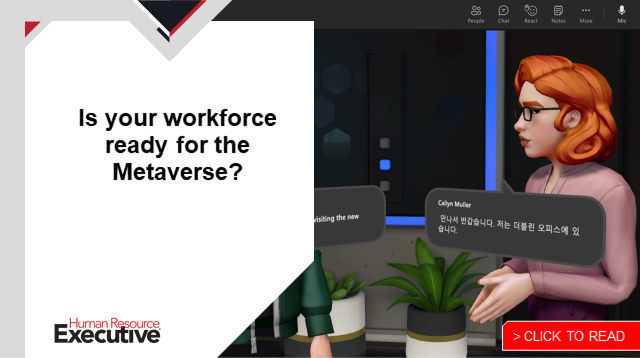It’s a buzzword across the globe: the “Great Resignation.” As quit rates in America continue to rise, this isn’t going to change any time soon.
But what if I told you this isn’t something to fear or try to reverse? What if it’s simply a chance to reflect, change direction and imagine a new future more beneficial for the employer and employee alike? Not a Great Resignation, but a Great Reimagination.
Terminology matters
Terms like the “Great Resignation” or the “War on Talent” make it seem as though there’s a winner and a loser—an “us” and a “them.”
It’s all based on a scarcity mindset. A belief that someone is going to miss out—and it better not be me! From my seat overseeing global recruitment for a growing tech company, this language creates fear rather than inspiration.
This pandemic guaranteed that every person, industry and organization experienced change over the past few years. We’ve all had to reevaluate our lives, think through what’s essential and determine what’s important. For a lot of us, that included our jobs.
 See also: Amid the Great Resignation, why some employers are boosting L&D budgets
See also: Amid the Great Resignation, why some employers are boosting L&D budgets
Team this reflection period with, for many, a first-time work-from-home experience, and we’re rethinking not only the kinds of work we want to do, but also how we want to do it.
This reevaluation process is not something that we should shy away from, even if it leads to restructuring. Reflection is an essential tool in growth and betterment. So, while your team may be changing shape, this period of time is a moment of possibility, not loss.
Discover what’s meaningful to your team
When we feel like we’re out of options, there is a human tendency to look outward instead of inward. Employers look at their competitors and want to match their offerings. Leaders hear a podcast, read an article or attend a seminar and want to immediately implement the lessons they learned along the way.
While it’s good to learn from others, this strategy focuses on solving the wrong problem. By looking outward, you’re more likely to start offering benefits your employees either don’t want or don’t take advantage of—all while failing to meet their genuine needs.
Understanding the why behind your employees’ movements can help you assess your offering and where you can make improvements.
While salary is obviously a huge factor, it isn’t the only one. And many workers will choose a company based on culture, values and benefits over one offering a higher salary.
Asking them what their priorities are, and whether they’ve changed, is an important step in retaining them long term.
There is not a shortage of talent, only a shortage of imagination
In 2021, Velocity Global had over 100,000 visits to our careers page. Of those 100,000, we had 26,000 people apply for a job. Of the 26,000, we hired 300.
There is not a shortage of talent.
And while there is no denying, more Americans left their jobs last year than any other year on record, most of them found work elsewhere.
 Derek Thompson, in a piece for the Atlantic, put it this way, “One problem with the term ‘Great Resignation’ is that resignation sounds like a pure subtraction.”
Derek Thompson, in a piece for the Atlantic, put it this way, “One problem with the term ‘Great Resignation’ is that resignation sounds like a pure subtraction.”
The problem isn’t a shortage of talent. The problem is rigidity in our thinking.
Employers are often not willing to look outside the box of their “perfect candidate,” which means they overlook transferable skills, don’t put in the effort to provide accessible workplaces and lack the understanding of what employees are really looking for.
These barriers turn potentially great candidates away. Or mean that we miss them when they do show up.
It is easier than ever to hire great talent across borders. On-the-job training and professional development help candidates transfer their skills across industries. Job sharing, restructuring or hiring contractors to fill in gaps can help create more part-time roles for working parents or students.
Moving away from rigid requirements exposes employers to a broader range of talent and, therefore, ideas, skill sets and personalities. This diversity ultimately pushes your business forward and has the potential to make your product offering even better.
Reimagine roles, as well as teams
 One thing I know for sure from my 30 years in recruitment is that people are looking for work that has meaning. So, if you can work with your employees to put them in roles that resonate with them, you’re more likely to retain them.
One thing I know for sure from my 30 years in recruitment is that people are looking for work that has meaning. So, if you can work with your employees to put them in roles that resonate with them, you’re more likely to retain them.
By reimagining what roles look like within our teams, we can create pathways that are personally meaningful while collectively productive. This might mean redistributing tasks across teams based on interest rather than roles.
For example, I have someone on my team who is great at speaking with candidates on the phone, they are great at building rapport, but they hate writing job descriptions. I also have someone on the team who loves writing job descriptions, but they don’t want to spend time on the phone. Technically, they have the same role but together we’ve created a more meaningful way to get these tasks done.
And that’s priceless. You can’t really put a monetary value on that.
Related: Transformation-Why it’s needed and how to get started
Reimagining the future
 Attracting and retaining top talent amid the Great Resignation may seem an impossible task. But the steps to reimagining the future of work are relatively simple.
Attracting and retaining top talent amid the Great Resignation may seem an impossible task. But the steps to reimagining the future of work are relatively simple.
Utilize this period of reflection to understand your employees better and design your culture and benefits around what they’d actually find useful. Broaden your talent pool by expanding globally, embrace flexibility and reimagine what roles could look like for folks with non-traditional needs. And work with your teams to create meaningful work they want to invest in.
With the possibility for happier, engaged and more diverse teams, you wouldn’t even know there is a “war on talent” out there.
The post Why HR shouldn’t fear the Great Resignation appeared first on HR Executive.